RBSE Solutions for Class 6 Science Chapter 17 Air, Water and Soil are part of RBSE Solutions for Class 6 Science. Here we have given Rajasthan Board RBSE Class 6 Science Chapter 17 Air, Water and Soil.
| Board | RBSE |
| Textbook | SIERT, Rajasthan |
| Class | Class 6 |
| Subject | Science |
| Chapter | Chapter 17 |
| Chapter Name | Air, Water and Soil |
| Number of Questions Solved | 59 |
| Category | RBSE Solutions |
Rajasthan Board RBSE Class 6 Science Chapter 17 Air, Water and Soil
In text Questions
Question 1.
Who moves the leaves and the branches?
(Page 139)
Answer:
Air.
Question 2.
Who blows straw and paper? (Page 139)
Answer:
Air.
Question 3.
What is air? (Page 139)
Answer:
Air is a mixture of gases.
Question 4.
How is oxygen gas replaced in the atmosphere? (Page 141)
Answer:
- Animals and plants take oxygen from the atmosphere and give out carbon dioxide gas in the atmosphere.
- During photosynthesis, plants take in carbon dioxide and release oxygen gas.
- The above mentioned processes occur simultaneously and so, the proportion of oxygen and carbon dioxide gas in the atmosphere remain constant. So, plants and animals are interdependent.
Activities
Activity – 1 (Page 139)
1. Take a container and fill it one-fourth with water.
2. Light the candle and fix it in the middle of the container and cover it with an inverted glass as shown in figure.
3. Immediately, mark the level of water in the glass.
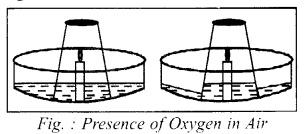
4. After sometime, observe the candle and the level of water in the glass.
Observation – The candle blows out and the level of water in the glass increases.
Question 1.
Why did this happen?
Answer:
We know that oxygen is a supporter of combustion, oxygen present inside the glass is used for burning of candle, when the oxygen present in the glass is used up by the burning candle, it can no longer bum and blows out and the water occupies the empty space. So, water rises up in the glass once the candle blows out.
Activity – 2 (Page 141)
Take an empty glass.
Question 1.
It is really empty or does it have something inside it?
Answer:
Yes, air is inside it.
Invert the glass in a container filled with water. observe the glass carefully?
Question 2.
Does water enter the glass?
Answer:
No, water does not enter into glass. Now tilt the glass slightly.
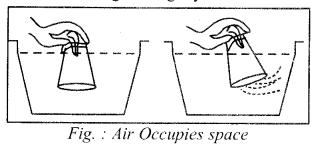
Question 3.
Does the water now enter the glass?
Answer:
Yes, now water enter into glass.
Question 4.
Do you see bubbles coming out of the glass?
Answer:
Yes, bubbles are coming out of the glass.
Question 5.
Can you guess what was in the glass?
Answer:
Air was present in the glass due to which bubbles seemed to come out of the glass and water filled up the empty space that air had occupied.
Activity – 3 (Page 142)
List all the activities for which you use water in a day. Discuss with your family members about the amount of water used in cooking, cleaning, in irrigating plants, drinking and other activities. Now find out how much water your family uses in a day.
Answer:
| S.No. | Activity | Water |
| 1. | In drinking water | 1 bucket |
| 2. | In tooth brushing | 1/2 bucket |
| 3. | In shower | 5 bucket |
| 4. | In washing clothes | 8 bucket |
| 5. | In clearing dishes | 3 bucket |
| 6. | In toilet | 5.1/2 bucket |
| 7. | In cleaning floors | 4 bucket |
| 8. | In cooking food | 2 bucket |
| 9. | In watering plants | 4 bucket |
| 10. | Any other activity | 2 bucket |
| Total amount of water used | 35 bucket |
Question 2.
Now, find out how much water your family uses in a day?
Answer:
35 buckets.
Question 3.
Now, divide this amount by the number of members in your family, to calculate amount of water used daily by one member.
Answer:
Members of the family = 5
Total amount of water used = 35 bucket
Water used per member = 35/5 = 7 bucket
Question 4.
How many people live in your village or city and how much amount of water will be needed for whole village or city in one year? Find out.
Answer:
Total members in our village = 450. If per member used 7 bucket water, then.
Water required in one day for 450 members = 450 x 7 = 3250 buckets
Amount of water in one year = 3250 x 365 = 1186250 buckets
Question 5.
What do you see?
Answer:
You will see that pieces of ice float on water due to decreased density of ice.
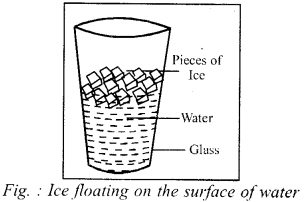
Exercises
Multiple Choice Questions
Question 1.
How much portion of the earth is covered with water?
(a) 3/4
(b) 1/2
(c) 1/4
(d) 1/3
Answer:
(a) 3/4
Question 2.
During respiration, which gas living beings take in?
(a) Oxygen
(b) Carbon dioxide
(c) Nitrogen
(d) Chlorine
Answer:
(a) Oxygen
Question 3.
Which is the most abundant gas in the atmosphere?
(a) Oxygen
(b) Nitrogen
(c) Carbon dioxide
(d) Other gases
Answer:
(b) Nitrogen
Fill in the blanks
1. During photosynthesis, plants take in ……………… gas.
2. The process of collecting and storing rain water is called …………………. .
3. Electricity is generated in …………….. by wind.
4. Afforestation helps in soil …………….. .
Answer:
1. Carbon dioxide
2. water harvesting
3. wind energy farm
4. conservation
Short Answer Type Questions
Question 1.
What are the different types of soil?
Answer:
Types of soil
- Sandy soil
- Clayey soil
- Loamy soil
Question 2.
Explain the various techniques of water conservation?
Answer:
- Do not allow wastage of water from the tap.
- Do not use shower while bathing, instead use bucket.
- Keep the drains clean.
- Keep away water sources from pollution.
Question 3.
Explain water cycle with a suitable diagram?
Answer:
Water from water bodies rises up in the form of water vaporous framed by evaporation. Clouds are formed due to condensation of water vaporous and then water returns back to the water bodies as rain. This circulation of water is called water cycle.
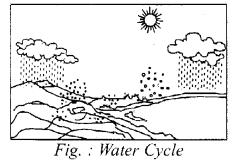
Question 4.
Water occupies space. Explains.
Answer:
We perform an activity to show’ that water occupies space.
(i) Take an empty balloon and sketch its outline on a paper.
(ii) Now fill water in balloon and tight its mouth. Again we draw its outlines on a paper.
Observation – We see that water filled balloon has large a shape. It is due to water filled in the balloon.
Deduction – This shows that water occupies space.
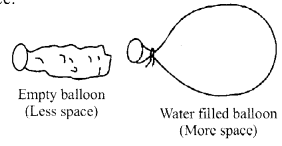
Question 5.
Explain the importance of oxygen in atmosphere?
Answer:
Oxygen is essential for respiration in animals and plants and in combustion of substances.
Long Answer Type Questions
Question 1.
Explain diagrammatically, the component of air in the atmosphere.
Answer:
Components of Air
- Water Vapour – When air in the atmosphere comes in contact with a cool surface, then the water vapour present in it, condenses and get converted into water droplets on cold surface.
- Oxygen – Oxygen is a component of air which is approximately 21 percent of the total air. It is essential for respiration in animals and plants and in combustion of substances.
- Nitrogen – Nitrogen is approximately 78 percent of the total air. It does not support burning.
- Carbon dioxide – Apart from oxygen, nitrogen and carbon dioxide gas, air also contains carbon monoxide, sulphur dioxide etc. These gases are present in a fixed proportion.
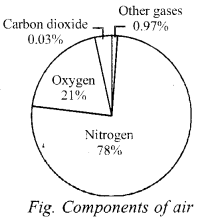
Question 2.
What is soil should be taken to prevent it?
Answer:
Soil erosion – The removal of topmost fertile layer of the soil by wind and water is known as soil erosion. Soil conservation is essential to protect soil from erosion. Following measures must be implemented to stop soil erosion :
- Afforestation must be done on large scale to protect the fertile soil from erosion.
- Natural forests must be conserved.
- While crop harvesting, roots must be left in the soil.
- Bio fencing must be done around the field.
Question 3.
Write various uses of water.
Answer:
Various uses of Water :
- Water is used for daily purposes like cooking, bathing, cleaning and drinking.
- Water is used as a universal solvent.
- Water maintains the temperature of our body.
- Water helps in digestion in our body.
- Water is used in factories and industries.
- Water is used to grow plants, vegetables and crops.
Creative Work
Question 1.
Make a rainwater harvesting model with the help of cardboard box and pipes.
Answer:
Do yourself.
Question 2.
Make a poster on the topic ‘methods to save water’ and include some slogans and display it on your school notice board.
Answer:
Student should make a poster of this type and paste it on school notice board.
Methods to save water :
- Do not allow wastage of water from the tap.
- Immediately repair any water leakage.
- Use less powerful washing machine.
- Keep the drains clean.
- Use slow flush in toilets or use bio-toilets.
- Turn off the tap while shaving or brushing teeth.
- Do not use shower while bathing, instead use bucket.
Slogns :
- Save water, save life
- Water is life, without water all are zero.
Question 3.
Develop a project to improve the water management in your area.
Answer:
For a good water management a large pond should be constructed at main place in village. It is good for rain water harvesting. The water of this pond can be used for drinking water of animals and for agriculture use. In rainy reason this pond can be filled up by pipes of home attached on the roof of homes.
Question 4.
Make a wind direction measuring device and find out the direction of wind.
Answer:
Student should do it self.
Question 5.
Make a model of the windmill.
Answer:
On the basis of figure the students should make itself.
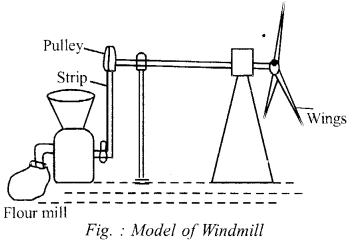
Other Important Questions
Multiple Choice Questions
Question 1.
Air is
(a) solution
(b) mixture
(c) compound
(d) element
Answer:
(b) mixture
Question 2.
In which district of Rajasthan, there is use of windmill :
(a) Jaisalmer
(b) Banner
(c) Pratapgarh
(d) All of these
Answer:
(d) All of these
Question 3.
The boiling point of water is
(a) 0°C
(b) 80°C
(c) 100°C
(d) 200°C
Answer:
(c) 100°C
Question 4.
That temperature at which water change into ice is called
(a) Vaporisation
(b) Freezing point
(c) Boiling point
(d) Melting point
Answer:
(b) Freezing point
Question 5.
The upper layer of soil has excess of
(a) Clay
(b) Gravel
(c) Humus
(d) All of these
Answer:
(c) Humus
Fill in the blanks
1. Air is colorless, odourless ……………. and ………… .
2. This component is , which is ……….. approximately 78 percent of the total air.
3. Animals and plants give out ………… in the atmosphere.
4. The gases of atmosphere have a fixed …………….. .
Answer:
1. tasteless
2. nitrogen
3. carbon dioxide
4. ratio
Very Short Answer Type Questions
Question 1.
Write two properties of air
Answer:
- Air is colourless, odourles and tasteless,
- Air exerts pressure.
Question 2.
What is atmosphere?
Answer:
The thin layer of air around the earth is called atmosphere.
Question 3.
What are the components of air?
Answer:
Components of air arc Nitrogen, Oxygen, Carbon Dioxide and other gases.
Question 4.
What are the properties of air according to place, weight and pressure?
Answer:
Air occupies space, has mass and exerts pressure.
Question 5.
What is wind energy?
Answer:
The kinetic energy generated due to moving air/wind is called wind energy.
Question 6.
Write formula of water and elements.
Answer:
The formula of water is H2O. It is made of 2 atoms of hydrogen and one atom of oxygen.
Question 7.
How do marine animals use oxygen for respiration?
Answer:
Marine animals use water dissolved oxygen.
Question 8.
Classify the soil.
Answer:

Short Answer Type Questions
Question 1.
How do oxygen and carbon dioxide make equilibrium in the atmosphere ?
Answer:
Animals and plants take oxygen from the atmosphere and give out carbon dioxide in the atmosphere. During photosynthesis, plants take in carbon dioxide and release oxygen gas. The above mentioned processes occur simultaneously and so, the proportion of oxygen and carbon dioxide gas in the atmosphere remains constant. So plants and animals are interdependent.
Question 2.
Write the percentage composition of gases in the atmosphere.
Answer:
| Name of Gases | Percentage Amount |
| Nitrogen | 78 |
| Oxygen | 21 |
| Carbon dioxide | 0.03 |
| Other gases | 0.97 |
Question 3.
Write the name of different sources of water.
Answer:
Ocean is the largest source of water. The water in the seas and oceans is saline due to the presence of salts and it is unfit for drinking. Other sources of water are rivers lakes, hand pump, wells, step well, tank, waterfalls and tube wells.
Question 4.
Write the physical and chemical properties of water.
Answer:
- Pure water is colorless, odorless, tasteless and transparent liquid.
- Boiling point of water is 100 degree Celsius and freezing point of water is 0 degree Celsius.
- When water forms ice (solid) on freezing, then the density of ice decreases.
Question 5.
Why do we say water as a universal solvent.
Answer:
Sugar is completely soluble in water. Oxygen is also soluble in water, due to which aquatic animals perform respiration, so we can say that water is a universal solvent.
Question 6.
What is soil?
Answer:
Soil is the uppermost part of the earth, which is formed by the mixture of various substances produced by the weathering of rocks and minerals and decomposition of organic matter, due to action of wind, water and climate.
Long Answer Type Questions
Question 1.
What is water harvesting? Why is it necessary? How can we harvest water?
Answer:
The process of collecting and storing rainwater is called water harvesting. Some part of water available on earth is used by plants and human beings. Most of the water is in the form of sea water which cannot be used directly. Due to less rainfall the level of ground water has decreased drastically. Factors like; increase in population, imbalance in rainfall, excessive use of water in industries, wastage of water etc, the amount of drinkable water is decreasing regularly. There are many reasons for the shortage of water. So, it is essential to collect and store rainwater to fulfill our water requirement.
Technique of water harvesting – The rainwater is collected from the rooftop into pits in the ground, through pipes. This water then seeps into the soil to refill the ground water. The water collected in the road side drains must be allowed to go directly into the ground.
Question 2.
How should we use water judiciously?
Answer:
Use of water judiciously
- Do not allow’ wastage of water from the tap.
- Immediately repair any water leakage.
- Use less powerful washing machine.
- Keep the drains clean.
- Use slow flush in toilets or use bio-toilets.
- Turn off the tap while shaving or brushing teeth.
- Do not use shower while bathing, instead use bucket.
We hope the RBSE Solutions for Class 6 Science Chapter 17 Air, Water and Soil will help you. If you have any query regarding Rajasthan Board RBSE Class 6 Science Chapter 17 Air, Water and Soil, drop a comment below and we will get back to you at the earliest.